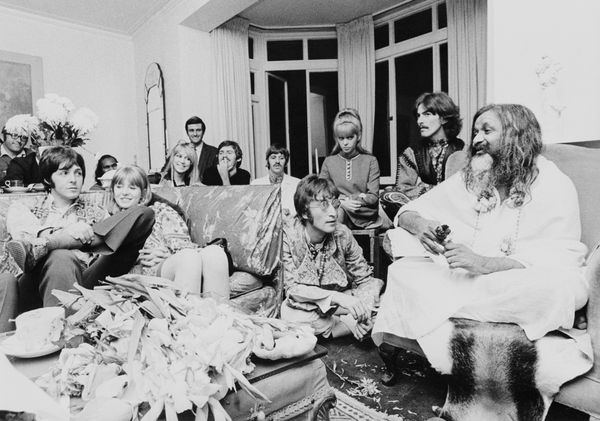Lynn Parramore • • 8 min read
Transcendental Meditation: How I Paid $2,500 For a Password to Inner Peace

Transcendental Meditation, that vestige of the 1960s fascination with Eastern-oriented enlightenment, is back with a vengeance. Celebs like Russell Brand and Moby swear by it. The celebrated filmmaker behind Blue Velvet and Eraserhead has made it his mission to spread the good word about TM through the David Lynch Foundation for Consciousness-Based Education and World Peace. Oprah recently devoted a TV show to the TM movement.
Over a decade ago, I found myself introduced to TM in what turned out to be a very expensive, hype-filled journey to enlightenment. Allow me to share the wisdom I gained.
The Price of Inner Peace
I was dating a screenwriter when I stumbled upon TM. He was nearly two decades older than me and had come of age in the late ’60s and early ’70s, bringing with him a number of interesting relics from that era, including a twice-daily practice of TM. Each morning he would sit up in bed for 30 minutes, chin resting on his chest, looking enviably blissful as I stumbled around in a bleary funk trying to find my shoes. In the afternoon, he would repeat this sublime performance. Neither deadline nor meeting could distract him from his ritual. If necessary, he would don earplugs and conduct his journey inward on the subway or the bus. I was in awe.
My boyfriend didn’t participate in the broader Transcendental Meditation movement and insisted that there was nothing mystical, or even particularly special, about what he was doing. “Look, I took a course 30 years ago, and I liked the technique, so I stuck with it. Period.” His daily practice, he assured me, had kept him grounded and sane ever since. That sounded pretty good to me. I’ve always been a rather high-strung creative type, and at the time I was in the throes of procrastination on my doctoral dissertation and a struggle to figure out whether a career in academia or journalism would best cure me of a deep sense of futility. So I signed up for a free introductory class on TM in Manhattan.
During the free intro, I heard a lot about scientific reports on the benefits of TM, like reducing stress and releasing creativity. It sounded reasonable enough, and I was impressed that the people in the room looked pretty normal. The instructor didn’t go into any religious stuff and could have easily fit into a corporate office with his clean-cut appearance and fondness for graphs and charts. The technique, he assured the class, was easy to learn and could provide a lifetime of benefits for both mind and body. We were invited to consider taking a beginner course, after which we would have access to a lifetime of “free followup and support.” Then came the kicker: the price of a beginner course was $2,500.
I gulped. That was quite a pricetag. But at this point, I was already looking forward to my transformation. Wasn’t inner peace worth it? I rationalized that people paid far more than this for therapy in New York City, and after all, I had hard evidence from my boyfriend that the technique could have long-lasting effects. I had just landed a lucrative ghostwriting contract, and if learning TM would make me less stressed and more productive, it would be worth it, right? My inner skeptic was silenced. I went for it.
Over several courses, I learned to sit with my eyes closed and just let my thoughts flow until I began to feel a sense of peaceful awareness come over me. There was no need to concentrate or sit in any particular way, or refrain from scratching my nose. A steady flow of references to scientific studies promising increased intelligence and emotional development padded what was otherwise a pretty straightforward lesson on sitting still and chilling out. After the completion of the course, there was a special “graduation” ceremony in which students were given individual mantras to use in our practice. This was the first real whiff of spirituality. I was told to bring an offering of flowers to meet the instructor, who now appeared wearing a robe. He solemnly told me that he had a special word to give me that was mine alone and would be the key to my successful practice of TM.
“I know something about you,” he said, staring meaningfully into my eyes. “And that’s why I’m giving you this particular mantra.” I was no longer a student in a class, but an initiate into a special order of enlightened beings. I was invited to attend group meditation sessions where the combined force of our effort would increase harmonic vibrations of the universe and contribute to global peace. Or something like that.
The Big Reveal
Meditation is an ancient technique for relaxing, and it comes in a variety of forms. Some focus on breathing; others on an object, like a flame or a bowl of water. Mindfulness meditation adds on the directive to be attentive to feelings of gratitude and not to be an asshole. There’s even a form that makes the orgasm the focus in reaching a meditative state.
Transcendental Meditation is just a fancy name for a common variety of meditation in which a mantra – a word or series of syllables – is repeated with the intention of creating a meditative state. Pretty much any word or syllable will do, despite the hype of TM, which insists that a mantra can only be given by a “qualified” instructor. The TM initiate is told never to reveal her mantra under any circumstances, lest its magic be lost. My instructor suggested that he had some particular insight into me in choosing my mantra, but this is utter nonsense. People who have taught TM have admitted that they are given a list of mantras they’re supposed to divvy out according to age and gender. Nothing mystical about it. Here’s one list, which contains a version of my “personal” mantra. In violation of the sacred rules of TM, I’m now going to reveal it to you: “aima.” That’s my mantra. Two syllables. Vaguely pleasant sounding. If I repeat it consistently for several minutes, I begin to feel a little spacey. The same thing happens, I have found, when I repeat the word “Tallahasee.”
My boyfriend was horrified that I had paid $2,500 to learn TM. His course cost him a mere $50 back in 1973, and as it turns out, he had long ago dispensed with the mantra-business and simply focused on an image when he sat down to meditate, which happened to be the sound of the blind on his childhood window tapping in the wind, a sound that to him signaled relaxation. Technically, he wasn’t even doing TM; he was simply relaxing for an hour a day. To achieve a similar result, some people take a nap. Others go for a walk. You could add all kinds of fancy components to a relaxing activity like walking, and call it Globally Conscious Perambulation or some such BS and require the muttering of special words and the donning of special attire, but it would still be a walk. Its primary benefits would still come from relaxing the body and mind, and if done regularly, adding some purposeful structure to the day. Dress it up in a thousand scientific studies and it’s still just a freaking walk.
TM merely adds a scientific veneer to a simple technique and pretends that there is something unique about it. There isn’t. You could stroll down to your local community center and learn to practice meditation, perhaps for a donation of ten bucks. I paid $2,500 for a mantra, which, I will now tell you, is idiotic. I’ve tried several forms of meditation since, and I actually find other techniques better suited to me. I’ve paid a couple of hundred bucks for weekend retreats and trivial amounts for group sessions at various centers, always in the form of voluntary donations. I don’t meditate regularly these days, but when I do, I often feel refreshed. But I will never feel good about the ridiculous amount of money I forked over to the Maharishi Mahesh Yogi and his merry band of hustlers.
The Giggling Guru
Unfortunately, one thing that links many forms of meditation is the preponderance of guru figures associated with it. This is not always the case, but it’s common enough to muddy the waters of the river of consciousness. For many practitioners, it’s not enough simply to pass on a simple technique that may be beneficial to some people. Those who aspire to gurudom have to be the voice of global consciousness. Or moral transcendence. Or whatever. They have to be the One Who Knows. And all too often, the One Who Gets Paid Big Bucks. Or perhaps the One Who is Having Sex With Disciples.
TM’s famous guru, the Maharishi Mahesh Yogi, known as the “giggling guru,” was an Indian yogi who rose to notoriety as the spiritual counselor to the Beatles. The giggling guru had plenty to smile about, as he got people to pay millions for his lessons on transcendence. According to Encyclopedia Britannica, his organization, which boasts real estate holdings, schools and clinics, was worth more than $3 billion by the late 1990s. Teaching meditation was never enough for the Maharishi, or “His Holiness,” as followers called him. A marketing wiz, he launched the official TM-Sidhi program in the late 1970s that offered devotees the ability to levitate and bring about world peace. The levitation, or “yogic flying,” as followers call it, basically involves sitting on your duff in lotus position and bouncing up and down in what is possibly the most ridiculous-looking New Age practice on Earth — and that’s saying something. This is thought to bring global consciousness. You really have to see it to believe it, so be sure to click here.
The Maharishi’s enthusiasm for the butt-flying technique actually led to the formation of a political party in 1992, the Natural Law Party, which runs campaigns in several countries, including the U.S. It must be admitted that most politicians speak out of their rear ends, so why not just make that part of the anatomy central to an entire platform? Makes sense to me.
In 2000, the tireless Maharishi created the Global Country of World Peace, a “country without borders” that even has its own currency, the “Raam.” In 2008, the guru announced his retirement, went into silence and promptly died. Transcendental Meditation, with its expensive classes and ridiculous advanced practices, might have fallen into oblivion, but for David Lynch. Lynch paid a small fortune for his guru status within the TM movement when, in 2003, he forked over a cool million to participate in the Maharishi’s four-week “Millionaire’s Enlightenment Course.” Since Lynch came on board, TM has been on the rise, perhaps benefitting from the decreasing market share of Scientology among celebrities.
Lynch has gotten a ton of press attention, including a recent profile in the New York Times. He has not been pleased, however, with all of it. In 2010, a German TM follower and filmmaker named David Sieveking produced a Roger and Me-style documentary about his quest to meet Lynch, which he eventually accomplished. In David Wants to Fly, the young man moves from an enthusiast of TM to a critic alarmed by the shaking-down of followers and the great wealth amassed by the leaders of a movement purportedly devoted to world peace. Sieveking claims to have received legal threats from the David Lynch Foundation since releasing the film.
As a concession to recessionary times, the TM movement dropped the price of its introductory course to $1,500 in 2008. That’s still an absurd amount of money for teaching a technique that could be learned in a hour. Any organization or movement that demands so much up-front cash from followers (still more if they choose advanced courses) and proffers such BS as global peace through butt-flying is bound to have a cultic dimension. I didn’t stick around long enough to explore it myself, but there are plenty of accounts of those who go beyond the initial meditation technique and find themselves feeling ripped off, angry and spiritually abused.
We humans are anxious, tired and distracted in the modern world. We need to relax. We just don’t need to pay thousands of dollars to do it.










